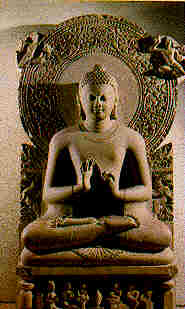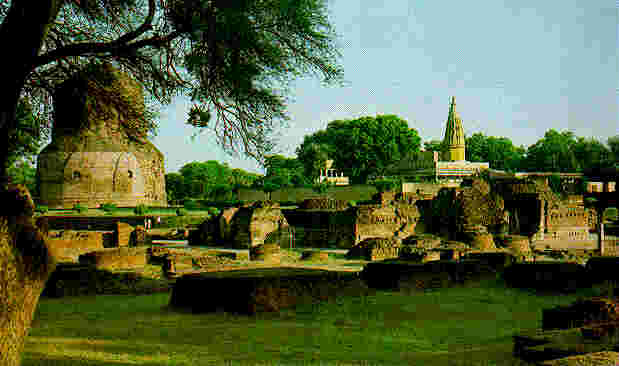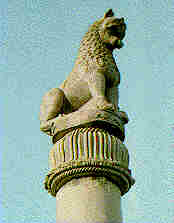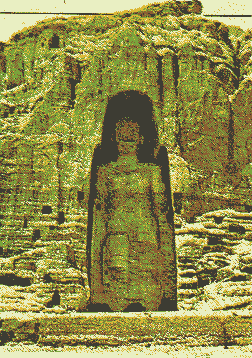BUDDHISM- Our Message of Peace, Non-violence and Goodwill
by YATIN JADHAV
_____________________________________________________________Table of Contents
_________________________________________________
The second great religion that originated in India is Buddhism. Ironically though Buddhism flourished overseas; in the land of its birth it was ti11 recently non-existent. It received a lease of life after independence, when Dr. B.R. Ambedkar decided to embrace Buddhism. A significant section of the scheduled castes followed Dr. Ambedkar and they today constitute an overwhelming portion of the adherents of Buddhism in India today. But they do not form part of the two traditional sects of Buddhism viz., (Mahanayana and Hinayana) and are generally termed as Neo-Buddhists (Nava-Baudha). The history of Buddhism in India starts with that of its founder Gautama Buddha who lived in the 6th century B.C.E.
 | Buddha - The Great Master This statue dates back to the 1st Century B.C.E. It was sculpted during the reign of of the Kushana Emperor Kanishka. |
Life Story of Buddha
Buddha was born in the Shakya clan that belonged to the warrior (Kshatriya) caste. His father was Shudhodana and his mother Maya. Before Buddha was born his mother had a dream in which a white elephant descended from heaven and entered her womb. Buddha was said to have been born in a grove named Lumbini near the ancient town of Kapilavastu. At birth the name given to him was Gautama, probably after the more ancient Vedic seer to whom some of the hymns in the Rigveda are ascribed. Buddha was also known as Siddhartha which means 'he whose aim is accomplished' The latter name seems to be a title given to him by his disciples} although varying opinions are held on this issue.
The Prophecy of Buddha
At his birth, a sage is said to have told King Shudhodana that Gautama would grow up to be a powerful king. But to become a king he should be kept away from the sorrows of 1ife. And if perchance he happened to see any of the sorrows of life he would become an universal teacher. Keen as King Shudhodhana was to see Gautama to be a successful ruler, he built up special palace for Gautama from where he could set his eyes on none of the world's sufferings. Even when the prince Gautama went out for stroll or ride, all unpleasant objects were removed so as to prevent Gautama's mind from being disturbed.
The Young Gautama is kept away from Real Life
But the prophesy of Gautama becoming an universal teacher was destined to be fulfilled. One day through some lapse, Gautama managed to s1ip out unnoticed from the palace. Riding through the streets of the city he saw for the first time in his life, a lame person, a sick person, a dead body and an ascetic.
These sights made a deep impact on his tender teenaged mind and he set thinking upon the cause of sufferings and sorrow. Consequently, Gautama began neglecting the affairs of the State which his father had assigned to him. Alarmed at his son's strange behaviour, King Shudhodana, to get his son off this brroding decided to marry him to a princess Yashodhara. Some days after marriage a son was born to them who was named Rahula.
But married life could not distract Gautama from his life's mission for long. When his patience was at the end of its tether, Gautawna decided to forsake family life and one day he slipped out of his palace along with his servant Chandaka. After moving out of the city, Gautema cut off his hair removed his royal ornaments and jewels, his rich garments and sandals and gave them to Chandaka and bid him to return to the palace with the news of his (Gautama's) departure.
 | Sarnath This place is also known as Isipatana or "Deer Park" Situated 5 Kms north of Varanasi, here the Buddha is said to have preached his first sermon. |
Gautama becomes The Buddha - The Enlightened One
Thus Gautama set out on his quest for the cause of sufferings (Klesha). He undertook severe austerities by fasting continuously. In this he was accompanied by five disciples. But his frail and pampered body could not stand up to this self-inflicted punishment and one day he fainted. Realizing that this was not the way to arrive at the truth, he gave up the austerities. Horrified at their Master's apostasy the five disciples left him. But undaunted, Gautama continued his quest for the cause of sufferings. He seated himself under a fig tree (Mahabodhi tree) and decided not get up unless he found answers to his questions. His enlightenment is said to have come suddenly and was exceedingly simple - viz., that all pain is caused - by desire, and therefore peace comes when one ceases to crave for anything. This thought was new at that age and it struck him with blinding force, and not only influenced his future life but left a lasting imprint on Buddhist philosophy. Freedom from all desires was said to release a person from the cycle of re-birth and lead to his salvation (Nirvana).
After this revelation Gautama started preaching to people and for this he travelled from place to place. He is said to have delivered his first sermon at a deer park (Isipatana) setting in motion, the wheel of law (Dharma-chakra or Dhammachakra in Pali).
As his teachings impressed people his following grew. Among his early converts were Sariputta, Mogallana and Ananda. He even received the patronage of rich traders like Anathapindika (i.e. feeder of poor) and powerful kinqs of the age like Ajatashatru of Magadha. After the revelation (Bodhi), Gautama came to be known as Buddha or Gautama Buddha.
 | The Boddhisattva Maiterya is a representation of the incarnation of Buddha to appear in the future. This representation is found at the famous Bharhut Stupa. |
He was also known as Shakyamuni (Sage of the Shakyas). The tree under which he attained enlightenment is known as the Bodhi or Mahabodhi tree But though he received an impressive following Buddha never claimed Divine status. Very few miracles are attributed to him.
"Miracles" by the Buddha
On one occasion a grieving lady carried her dead child to Buddha and asked him to revive it. This was a perfect setting for a miracle to be woven into religious folklore, but Buddhist records state that Buddha calmed the lady and told her that he would require three mustard seeds to revive her child. But the mustard seeds should be from a family where so far no one has ever died. To fulfill this seemingly simple request the lady went from house to house only to be told that sometime or the other, someone had died in every family. Gradually, the truth dawned upon the grieving lady and going to a cemetery, she laid down her child's body and taking its little hand in hers, she said "Beloved son, I thought that death has overtaken you alone. but no it overtakes all of us". She went back to Buddha and became his disciple.The Buddhist Sangha and Morality
Buddhism is unique among religions in a fundamental sense. It does not advocate invocation of any God. Salvation can be attained by controlling one's desire; as desire is the cause of suffering. The original Buddhism had neither God nor Devil. The emphasis was not on prayer but on controlling one's mind. In this sense it was more a worldly philosophy rather than a religion. But with the passage of time it acquired the nature of a religion complete with dogmas and rituals. Buddha's life-story is an eventful one. The most potent institution that Buddha established during his lifetime was the Sangha (monastic order) into which men were admitted irrsespective of their caste. The members of the Sangha who were known as Bhikkus (beggars)had to lead a rigorous life devoid of all desires. Their daily needs were limited to those necessary for physical survival. Their only possessions were a begging bowl, yellow coloured loin cloth, a walking stick if necessary and a pair of sandals for the more delicate. They were to sustain themselves by the alms they received but were forbidden from expressly begging for alms. Alms were to be accepted if given willingly and if not the Bhikkus were to move on to the next house. Thus came into being a clergy, but which unlike its Hinducounterpart was not based on caste and which was oriented towards missionary activities rather on the performance and upholding of rituals.
The break of Buddhism from other forms of worship that constituted Hinduism was almost complete in the lifetime of Buddha. This took the form of non-recognition of any personified Gods, spirits or the devil, and the near absence of rituals, repudiation of the caste system and the intense missionary activity of the monks which included rendering social service with the aim of alleviation of human suffering. Another significant aspect was that in the early stages all followers of Buddha were enrolled as members of the Sangha hence it was completely a missionary religion.
 | The Dalai Lama The Buddhist spiritual leader from Tibet. In the early days, many young men were fired by the message of the Buddha and took up a life of a Bhikku which meant renunciation from all the material pleasures of life. |
The distinction between the Bhikkus and other lay adherents of Buddhism came about later when the following of the religion increased manifold.
From its inception Buddhism received royal patronage. In the lifetime of Buddha Ajatashatru the king of north India's most powerful kingdom Magadha (in present-day Bihar) patronised Buddhism during Buddha's lifetime, and a few years after Buddha attained Nirvana {Salvation), the first religious council of the Buddhists was held at the town Rajagriha, which was the capital of Magadha from where Ajatashatru ruled. Councils such as this one were occasions for formulation and revision of the Buddhist religious code which was supposed to be adhered to by all followers. Thus it kept a check on the emergence of sub-sects- a tendency which is a hallmark o� Hinduism.
The second such council was held at Vaishali also in Magadha, about a hundred years after the first council i.e. in the 5th century B.C.E.
Relations Between Buddhism and Hinduism
Buddhism continued to grow steadily in the first few centuries after its birth. The reasons were its universal appeal, humane outlook, emphasis on missionary and social work and finally its peaceable methods that limited confrontation with the established local religions to a philosophical level. Thus even kings who patronised Hinduism did not feel it necessary to make a distinction between Hinduism and Buddhism in policy matters. Buddhism normally returned the sympathy of the ruling power by giving it a moral legitimacy amongst the lay people. And although Brahmin orthodoxy did grudge the inroads made into itself by the new faith there hardly ever was there active confrontation between the two faiths.
On the contrary there was a exchange of beliefs and attitudes between Hinduism and Buddhism. The Hindu insistence of vegetarianism and non-violence (Ahimsa) are borrowed from Buddhism (and Jainism). Hinduism in turn tried to absorb Buddhism within itself by making Buddha one of the incarnations of Vishnu.
Major Royal Patrons - Samrat Ashok Maurya, Kanishka, Harsha Vardhana
The growth of Buddhism received a tremendous boost in the 3rd century B.C.E. when Samrat Ashoka Maurya whose empire covered nearly the whole of India (including present-day Pakistan and Afghanistan) was converted to Buddhism.
 | The Lion-Capital at Sarnath. - Emperor Ashoka erected such Lion Capitals and other similar looking columns all across his empire in India (and Pakistan) He spread the message of Buddhism in Central Asia and the Far East. |
Samrat Ashoka elevated Buddhism to the level of a state religion and sent missionaries not only to all parts of India but also to Sri Lanka, West Asia, Central Asia and China. In his days Buddhism is said to have spread in varying degrees up to Egypt and South-western Russia. Since the days of emperor Ashoka, Buddhist missionaries built majestic monasteries known as Viharas, Stupas and Chaityas.
 | A Chorten This is a Buddhist place of worship. Chortens are found in Nepal and Tibet and look like inverted bells. |
The simple ascetic character of Buddhism had received its first dent under the pampering effect of royal patronage. The religlon continued to grow nevertheless. During the reign of Ashoka the third Religious Council was held at Pataliputra which was the capital of Ashoka's vast empire.
But that Ashoka was not inimical to Hinduism is evident from one of the titles that he took viz. Deva-naam-priya (Beloved of the Gods).
After the fall of the Maurya empire, Buddhism did not receive official patronage on a comparable scale for a long time. During the period after the Maurya empire, India was beset with invasions from the Indo-Greeks, Kushanas, Parthians, etc. But most of these invaders acculturized themselves in a few years after their coming and many of their kings embraced either Buddhism or Hinduism. Prominent among them were, Menander (Milinda) who was an Indo-Greek and to whom is ascribed the Buddhist treatise called Milinda-Panho (Questions of Menander) in which thc king, posed certain questions to which answers were given by a Buddhist Sage called Nagasena. The next major royal patron of Buddhism was Kushana who was a Mongol king who ruled north India, Pakistan and Afghanistan in the 1st century B.C.E. In his reign) the fourth religious council was held at Jalandhara (Modern Jullundar in Indian Punjab). Now Buddhism had spread far and wide and had received royal patronage in varying degrees almost continuously from one king or another since Ashoka.
Split into Two Sects - Mahayana (Greater Vehicle) and Hinayana (Lesser Vehicle)
By the time the fourth religious council was held, the religion had vertically split up into two schools. One school had elevated Buddha to the status of a God and introduced worship of the Buddha's image (idol), it also evolved elaborate rituals which were derived largely from Hinduism, and gave up the rigorous ascetic life in monasteries, discarded Pall and accepted Sanskrit as the literary medium. These changes had far-reaching effects in narrowing the breach between Buddhism and Hinduism but at the cost of departing from the essence of the way of life that Buddha established. This school was called the Mahayana {Greater Vehicle) school or the northern school of Buddhism. On the other hand the Hinayana (Lesser Vehicle) school stuck to the original character of Buddhism with its emphasis on rigorous and simple living although idol worship gradually made its way into Hinayana also. This school is also known as Theravada (from Staieryavada l. e. principle of stability) is mainly prevalent in Sri Lanka, Burma and Thailand.
 | The Kanheri Caves near Mumbai. These caves were Buddhist Monasteries in the period 3rd century B.C.E. There are innumerable such cave monasteries be found especially in Western India. |
Despite the split, Buddhism continued to grow steadily up to the reign of the Guptas.
Since the reign of the Gupta kings (3rd and 4th centuries C.E.) the growth of Buddhism came to a standstill and gradually the decline set in. The reasons for this decline could be many but the principal one was to be the absence of royal patronage since the Gupta period, although there was no persecution either.
The last known royal patron of Buddhism was Harsh Vardhana who ruled over a large part of northern India around the 7th century C.E. Harsha who was an ardent worshipper of the Hindu deity - Shiva, did not embrace Buddhism, but he extended many favours to the religion. During his reign the fifth religious council was held at Prayaga (Allahabad).
No significant event took place thereafter in the history of Buddhism. But it is certain that upto the beginning of the Gupta period the religion was on its ascendance and its following in India was significant. From the Gupta period Hinduism seems to have undergone a revival, partly under the patronage of the Gupta kings. Buddhism then onwards was definitely on the decline. The intellectual onslaught of Brahmanic philosophers like Adi Shankaracharya seems to have had its toll in emasculating what was once a cohesive and vibrant way of life. Whatever the reasons, it is certain that the following of Buddhism declined sharply during and after the Gupta perlod.
It survived nominally as an intellectual tradition kept alive by the select monks who controlled the monastic universities like the one at Nalanda. These universities were highly respected as seats of learning and attracted students from abroad. Fa Hien, Huien Tsiang and I-Tsing who came from China were said to have studied at Nalanda and other centres of Buddhist learning. But from the 5th century Onwards, Buddhism declined as the religion of the masses. Its following seems to have been absorbed into Hinduism, although this could have also been the result not of formal conversion but of a gradual relapse of the Buddhist laity into the parent religion. The portrayal of Buddha as an incarnation of the Hindu deity Vishnu, and the absorption of many Hindu attitudes by Mahayana Buddhism, along with the absence of royal patronage to Buddhism (and the extension of this patronage to Hinduism during Gupta times) must have contributed to this effect. Whatever Buddhists that remained constituted an elite who inhabited the Monasteries and rarely ventured out of them. Missionary activity was nearly absent.
 | The imposing pyramidal Mahabodhi Temple at Bodh Gaya in Bihar The tower soars to a height of 180 ft. Close to the temple near the west wall grows a pipal tree which is said to be descended from the original Bodhi tree under which the Buddha received enligthenment. |
Muslim Invasions give the Fatal Blow to Buddhism
The last fatal blow to this once virile religion came from a non-Indian impetus - the Muslim invasion of north India in the 12th century. The defeat of Prithviraj Chauhan and Jaichandra Gahadawal (Rathore) in 1192 and 1194 respectively by the Afghan raider, Mahmud Ghori opened up the Gangetic plains to the ruthless invader where the Buddhist (and Hindu) centres of learning were located. The destruction of monasteries and the slaughter of monks that followed the headlong rush, of the Muslim invaders, down the Ganges stilled the agony of this once glorious order into the silence of death.
Thus passed out of existence in the land of its birth a religion that touched the lives of millions of humans not only in India but in China, Japan, Korea and other countries of Central Asia and South-East Asia. Buddhism in India was to remain a dead religion until the 20th century.
Buddhism Resurrected in India in the 20th Century
In the mid 20th Century, Dr. B.R. Ambedkar, who was one of the architects of India's Constitution, gave Buddhism a fresh lease of life by embracing it a few years after India achieved independence. A significant number of members of those castes who were denied equal rights in the Hindu caste hierarchy also embraced Buddhism. Today an over-whelming proportion of Buddhists in India are these recent converts who term themselves as Nava-Baudha or Neo-Buddhists. A comparatively recent event of significance was the 6th religious council held at Rangoon in 1954 which came 1300 years after the 5th council held at, Prayaga in 643 C.E. in the reign of the last major pan-Indian emperor - Harsha Vardhana. The Rangoon council was also the first one to be held outside India.
Buddhism and Hinduism - Umbilical Marks
In the course of its eventful history Buddhism which began as a departure from the ritualism of the Hindu religion gradually adapted and absorbed many Hindu ideas and practices to the point that at times, the lines of distinction between the two religions (the parent and the offspring) were blurred. The objective of Nirvana towards which every Buddhist is supposed to strive is undoubtedly an adaptation of the Hindu concept of Moksha. The difference is that for the attainment of Moksha righteous behaviour and the conformation of duties as assigned by the caste into which a person has been born is necessary, while for the attainment of Nirvana a person has to be free of all desires. But the essence of both concepts is the release from the cycle of re-birth. The daily of life of the Buddhist Bhikkus (missionary ascetics) was evidently inspired by the concept and practice of Sanyasa which was the last phase of life a Hindu during which he was supposed to be free of al1 desires and to roam from place to place in search of spiritual enlightenment while spreading the gospel of rightousness among the people. The yellow coloured robes that the Buddhist Bhikkus donned were borrowed from the Saffron robes of the Hindu ascetic. Although as for the Buddhists the yellow colour was chosen to represent an autumn leaf which was once green but has inevitably turned yellow in conformation with the law that everything born has to decay and pass away.
Among the auxiliary Hindu practices which found their way into Buddhism, idol worship and the use of Sanskrit as the liturgical and scriptural language. The Buddhist conception of Buddha as a God and that in a later period after five thousand years when righteousness suffer an eclipse the Buddha will reappear on the earth. This Buddha who will be known as Maiterya will restore the rule of dhamma (law and religion). This idea implies belief in incarnations and re-incarnations on lines parallel to the Hindu concept of Kalki who, we are told, is to be the future incarnation of Lord Vishnu.
But all said and done though Buddhism precariously came close to Hinduism it maintained its distinct entity unlike the Jaina religion whose proximity to Hinduism nearly made it a part of Hinduism. In its appeal Buddhism was not, like its parent religion Hinduism, restricted to India and Indians but spread far and wide.
 | Guilded image of the Buddha from Thailand With its message of love, peace and universal brotherhood Buddhism has exercised a sobering influence on a section of humanity in the countries of the far east. |
Thus in Buddhism, India gave birth to a major international religion, while the Hindus continued their way. Buddhism was the world's first missionary religion and won its triumphs through missionary activity. The ancient Buddhist monks who carried the Master's message of peace, love and universal brotherhood were pioneers in such a mission in Human history.
Buddhism is the only trans-national religion which has never preached malice against other faiths, nor have its followers ever indulged in a holy war against those of another faith. Buddhism has won its way by persuasion and never by the sword, nor has it ever used its position or power to compel conformity to its precepts.
And whatever its defects, it has unquestionably done much to benefit the human race by introducing and perpetuating a higher standard of conduct in life. One is inclined to bow before the Buddha, not in homage to a deity but in recognition to a superior craftsman in the art of living.
 | A gigantic image of the Great Master - Buddha at Bamiyan near Kabul in Afghanistan. It is this image which has been threatened to be blown off by the Taliban, the Islamic militia that rules Afghanistan. The statue faced its first defilement at the hands of Islamic invaders when they invaded pre-dominantly Buddhist Afghanistan in the 8th century Incidentally the name Afghanistan is derived from the Sanskrit terms Upa-gana-stan which means "Lands where the Allied tribes live". |
कोणत्याही टिप्पण्या नाहीत:
टिप्पणी पोस्ट करा